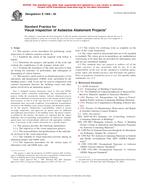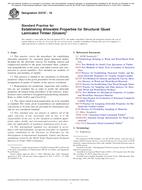1.1 This test method covers a procedure for predicting the long-term thermal resistance (LTTR) of unfaced or permeably faced rigid gas-filled closed-cell foam insulations by reducing the specimen thickness to accelerate aging under controlled laboratory conditions (1-5) .
Note 1 – See Terminology, 3.2.1, for the meaning of the word aging within this standard.
1.2 Rigid gas-filled closed-cell foam insulation includes all cellular plastic insulations manufactured with the intent to retain a blowing agent other than air.
1.3 This test method is limited to unfaced or permeably faced, homogeneous materials. This method is applied to a wide range of rigid closed-cell foam insulation types, including but not limited to: extruded polystyrene, polyurethane, polyisocyanurate, and phenolic. This test method does not apply to impermeably faced rigid closed-cell foams or to rigid closed-cell bun stock foams.
Note 2 – See Note 8 for more details regarding the applicability of this test method to rigid closed-cell bun stock foams.
1.4 This test method utilizes referenced standard test procedures for measuring thermal resistance. Periodic measurements are performed on specimens to observe the effects of aging. Specimens of reduced thickness (that is, thin slices) are used to shorten the time required for these observations. The results of these measurements are used to predict the long-term thermal resistance of the material.
1.5 The test method is given in two parts. The Prescriptive Method in Part A provides long-term thermal resistance values on a consistent basis that can be used for a variety of purposes, including product evaluation, specifications, or product comparisons. The Research Method in part B provides a general relationship between thermal conductivity, age, and product thickness.
1.5.1 To use the Prescriptive Method, the date of manufacture must be known, which usually involves the cooperation of the manufacturer.
1.6 The values stated in either SI units or inch-pound units are to be regarded separately as standard. The values stated in each system may not be exact equivalents; therefore, each system shall be used independently of the other. Combining values from the two systems may result in non-conformance with the standard.
1.7 This standard does not purport to address all of the safety concerns, if any, associated with its use. It is the responsibility of the user of this standard to establish appropriate safety and health practices and determine the applicability of regulatory limitations prior to use.
Product Details
- Published:
- 05/15/2011
- Number of Pages:
- 21
- File Size:
- 1 file , 650 KB
- Redline File Size:
- 2 files , 1.2 MB


